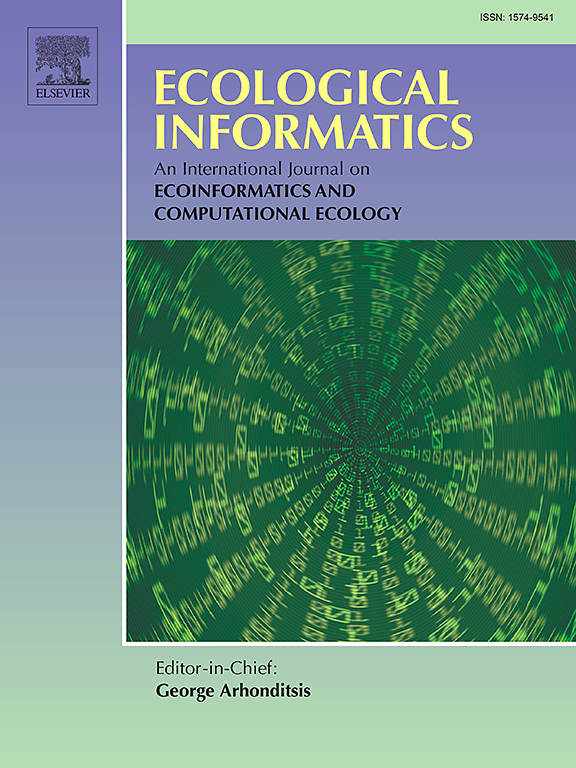Cetacean feeding modelling using machine learning: A case study of the Central-Eastern Mediterranean Sea
IF 5.8
2区 环境科学与生态学
Q1 ECOLOGY
引用次数: 0
Abstract
Investigating environmental drivers of cetacean feeding behaviour is essential for effective marine resource management, especially in the Mediterranean Sea, a biodiversity hotspot heavily impacted by human activities and climate change. This study realized a pioneer assessment of feeding activity related to the marine environment for three cetacean species - striped dolphin, common bottlenose dolphin, and Risso's dolphin - in the Gulf of Taranto (Northern Ionian Sea, Central-eastern Mediterranean) using an innovative Machine Learning (ML) approach. Behavioural data from April 2016 to October 2023, coupled with 20 environmental variables from Copernicus Marine Service and EMODnet-bathymetry datasets, were used to build Cetacean Feeding Models (CFMs) for the target species using Random Forest and RUSBoost algorithms. Multiple subsets of environmental predictors—physiographic, physical, inorganic, and bio-chemical—were employed to develop and evaluate ML models tailored to feeding prediction. Risso's dolphin resulted to be the best modelled species, with the bio-chemical model based on the RUSBoost algorithm achieving a Balanced Classification Rate (BCR) of 94 %, primarily influenced by 3D chlorophyll-a concentrations, a close proxy for prey availability. The second-best model was the physical one for the common bottlenose dolphin with a BCR of 72 %, influenced by salinity, currents speed, and temperature. These differences in predictive performance might reflect the distinct trophic niches of the studied odontocetes. Finally, simulated predictive maps of Risso's dolphin feeding habitats for summer months were realized in the Gulf of Taranto, providing actionable insights for conservation and sustainable management. The developed CFMs enhance understanding of cetacean feeding preferences and offer a versatile framework for integrating behavioural processes into species distribution models to inform area-based conservation measures, with significant potential for application across other Mediterranean areas.

使用机器学习的鲸类动物喂养模型:地中海中东部的案例研究
研究鲸类摄食行为的环境驱动因素对于有效的海洋资源管理至关重要,特别是在受人类活动和气候变化严重影响的生物多样性热点地中海。本研究利用创新的机器学习(ML)方法,对塔兰托湾(北爱奥尼亚海,地中海中东部)的三种鲸目动物——条纹海豚、普通宽吻海豚和里索海豚——与海洋环境相关的摄食活动进行了开创性的评估。2016年4月至2023年10月的行为数据,结合来自哥白尼海洋服务和emodnet测深数据集的20个环境变量,使用随机森林和RUSBoost算法建立目标物种的鲸类摄食模型(cfm)。环境预测因子的多个子集——地理的、物理的、无机的和生物化学的——被用来开发和评估适合于喂养预测的ML模型。结果表明,Risso海豚是最佳的模型物种,基于RUSBoost算法的生化模型实现了94%的平衡分类率(BCR),主要受3D叶绿素-a浓度的影响,这是猎物可用性的密切代表。第二好的模型是普通宽吻海豚的物理模型,BCR为72%,受盐度、水流速度和温度的影响。这些预测性能的差异可能反映了所研究齿螈不同的营养生态位。最后,在塔兰托湾实现了夏季Risso海豚摄食栖息地的模拟预测图,为保护和可持续管理提供了可行的见解。开发的cfm增强了对鲸类动物摄食偏好的理解,并为将行为过程整合到物种分布模型中提供了一个通用框架,为基于区域的保护措施提供信息,具有在其他地中海地区应用的巨大潜力。
本文章由计算机程序翻译,如有差异,请以英文原文为准。
求助全文
约1分钟内获得全文
求助全文
来源期刊

Ecological Informatics
环境科学-生态学
CiteScore
8.30
自引率
11.80%
发文量
346
审稿时长
46 days
期刊介绍:
The journal Ecological Informatics is devoted to the publication of high quality, peer-reviewed articles on all aspects of computational ecology, data science and biogeography. The scope of the journal takes into account the data-intensive nature of ecology, the growing capacity of information technology to access, harness and leverage complex data as well as the critical need for informing sustainable management in view of global environmental and climate change.
The nature of the journal is interdisciplinary at the crossover between ecology and informatics. It focuses on novel concepts and techniques for image- and genome-based monitoring and interpretation, sensor- and multimedia-based data acquisition, internet-based data archiving and sharing, data assimilation, modelling and prediction of ecological data.
 求助内容:
求助内容: 应助结果提醒方式:
应助结果提醒方式:


